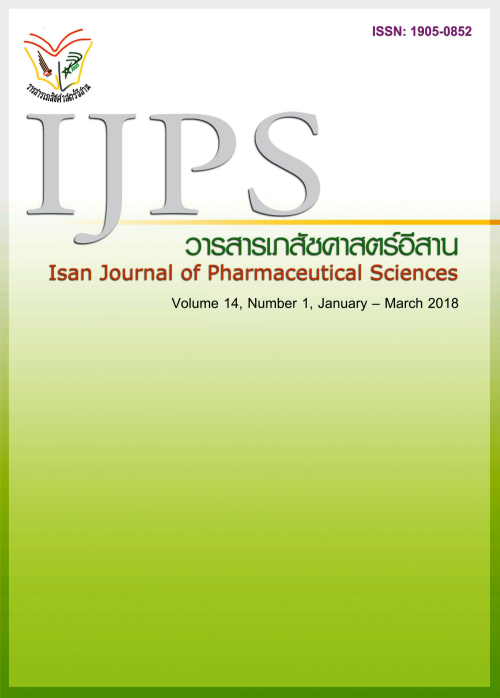Quantitative Determination of Bergenin in Mallotus repandus (Willd.) Muell. Arg. Stem Extract by Reverse Phase-High Performance Liquid Chromatography
Main Article Content
Abstract
Bergenin, a polyphenol compound, is a major active constituent of Mallotus repandus (Willd.) Muell. Arg. which possesses pharmacological activities including anti-oxidant, hepatoprotective, anti-microbial, anti-inflammatory, and immunomodulatory activities. Objectives: To develop and validate the reverse phase-high performance liquid chromatography (RP-HPLC) for quantification of bergenin in M. repandus stem extract. Methods: The RP-HPLC was employed with Phenomenex Luna C18 column (250 mm x 4.6 mm, 5 mm) as stationary phase. The mobile phase consisted of acetonitrile : water (10 : 90 v/v), at a flow rate of 1 mL/min. The wavelength at 272 nm was used for detection of bergenin. Results: The retention time of bergenin was 10.885 min with no peak interference. The method at the bergenin concentration range of 20-320 mg/mL was in a good linearity (R2 = 0.9999). The accuracy measured as %recovery was 93.22 ± 1.49%. The precision of within-day and between-day expressed as %relative standard deviation were of 0.57-1.48% and 0.19-1.70%, respectively. Limit of detection and limit of quantification were 4.56 and 15.20 mg/mL, respectively. By the soxhlet extraction and maceration, the aqueous extract of M. repandus stem had the highest bergenin content of 12.67 ± 0.26% and 19.38 ± 0.63% dry% weight, respectively, followed by methanolic (9.28 ± 0.49% and 8.73 ± 0.72% ) and ethanolic extracts (2.16 ± 0.10% and 1.73 ± 0.05%), respectively. Conclusion: The RP-HPLC method for determination of bergenin was achieved with good and acceptable specificity, linearity, accuracy, precision, and sensitivity. The utilization was assured by determination of bergenin content in the M. repandus stem extracts.
Article Details
In the case that some parts are used by others The author must Confirm that obtaining permission to use some of the original authors. And must attach evidence That the permission has been included
References
Aguilar MI. Reversed-phase high-performance liquid chromatography. Methods Mol Biol 2004; 251: 9-22.
Gao XJ, Guo MY, Zhang ZC, Wang TC, Cao YG, Zhang NS. Bergenin plays an anti-Inflammatory role via the modulation of MAPK and NF-kB signaling pathways in a mouse model of LPS-induced mastitis. Inflammation 2015; 38(3): 1142-1150.
Haribabu K, Ajitha M, Ramesh B, Babu K, Rao J. Quantification of bergenin from Mallotus philippinensis by HPTLC-MS and study on different extraction methods. J Planar Chromat 2012; 25(5): 445-449
Hasan M, Uddin N, Hasan R, Islam M, Hossain M, Rahman AB, et al. Anagesic and anti-inflammatory activities of leaf of Mallotus repandus (Willd.) Muell. Arg. Biomed Res Int 2014: 1-7.
International Conference on Harmonization (ICH) of Technical Requirements for the Registration of Pharmaceuticals for Human use. Validation of analytical proceders: text and methodology Q2(R1). Geneva, Switzerland; 2005.
Khan H, Amin H, Ullah A, et al. Antioxidant and Antiplasmodial Activities of Bergenin and 11-O-Galloylbergenin Isolated from Mallotus philippensis. Oxid Med Cell Longev 2016: 1-6.
Li TSC. Taiwanese native medicinal plants: phytopharmacology and therapeutic values. New York: CRC press; 2006.
Lim HK, Kim HS, Choi HS, et al. Effects of bergenin, the major constituent of Mallotus japonicus against D-galactosamine-induced hepatotoxicity in rats. Pharmacology 2001; 63(2): 71–75.
Lin JM, Lin CC, Chen MF, Ujiie T, Takada A. Scavenging effect of Mallotus repandus on active oxygen species. J Ethnopharmacol 1995; 46(3): 175-181.
Loescher CM, Morton DW, Razic S, Agatonovic-Kustrin S. High performance thin layer chromatography (HPTLC) and high performance liquid chromatography (HPLC) for the qualitative and quantitative analysis of Calendula officinalis-advantages and limitations. J Pharm Biomed Anal 2014; 98: 52-59.
Majekodunmi SO. Review of extraction of medicinal plants for pharmaceutical research. Merit Res J Med Med Sci 2015; 3(11): 521-527.
Nazir N, Koul S, Qurishi MA, et al. Immunomodulatory effect of bergenin and norbergenin against adjuvant-induced arthritis–a flow cytometric study. J Ethnopharmacol 2007; 112(2): 401–405.
Nazir N, Koul S, Qurishi MA, Najar MH, Zargar MI. Evaluation of antioxidant and antimicrobial activities of bergenin and its derivatives obtained by chemoenzymatic synthesis. Eur J Med Chem 2011; 46(6): 2415–2420.
Pushpalatha HB, Pramod K, Devanathan R, Sundaram R. Use of bergenin as an analytical marker for standardization of the polyherbal formulation containing Saxifraga ligulata. Pharmacogn Mag 2015; 11: 60-65.
Rieivre C, Hong VNT, Hong QT, et al. Mallotus species from Vietnamese mountainous areas: Phytochemistry and pharmacological activities. Phytochem Rev 2010; 9: 217-253.
Shabir GA. Validation of high-performance liquid chromatography methods for pharmaceutical analysis: Understanding the differences and similarities between validation requirements of the US Food and Drug Administration, the US Pharmacopeia and the International Conference on Harmonization. J Chromatogr 2003; 987: 57-66.
Singh DP, Srivastava SK, Govindarajan R, Rawat KS. High-performance liquid chromatographic determination of bergenin in different Bergenia species. Acta Chromatogr 2007; 19: 246-252.
Tistaert C, Dejaegher B, Chataigne, et al. Potential antioxidant compounds in Mallotus species fingerprints Part II: Fingerprint alignment, data analysis and peak identification. Anal Chim Acta 2012; 721: 35-43.
Wuttidhammaved W. The Rattanakosin pharmacy ancient book. Bangkok: Odian store; 2007.
Yun J, Lee Y, Yun K, Oh S. Bergenin decreases the morphine-induced physical dependence via antioxidative activity in mice. Arch Pharm Res 2015; 38: 1248-1254.
Zhou D, Qin X, Zhang ZR, Huang Y. Physicochemical properties of bergenin. Pharmazie 2008; 63(5): 366-371.


